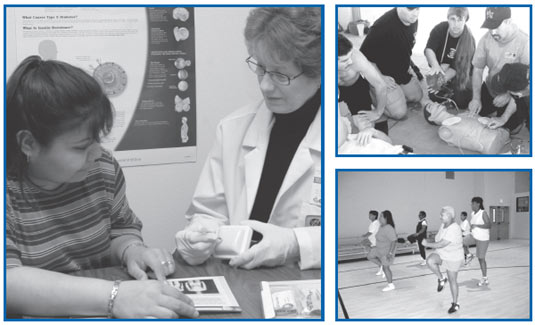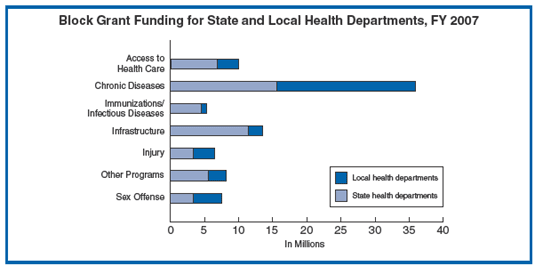 |

|
 |
 |
 |
Preventive Health And Health Services Block Grant
A Critical Public Health Resource
At A Glance
2008
This document is also available in
Portable Document Format (PDF–1Mb).
Learn more about
PDFs.

“The PHHS Block Grant is the only source of funding for
a range of disease interventions that are important to the public but which
do not have designated funding. It also allows states to address the
underlying causes of the major chronic disease killers—cardiovascular
disease, diabetes, stroke,
and cancer.”
J. Nick Baird, MD
Director,
Ohio Department of Health
The Role of Block Grant Funding
In 1981, Congress authorized the Preventive Health and Health Services (PHHS)
Block Grant. The PHHS Block Grant gives its 61 grantees—which include all 50
states, the District of Columbia, 2 American Indian tribes, and 8 U.S.
territories—the autonomy and flexibility to tailor prevention and health
promotion programs to their particular public health needs. States are
expected to align their programs with Healthy People 2010 national
health goals. The overarching goals of the PHHS Block Grant are to
- Create healthy communities.
- Improve disease surveillance.
- Increase life expectancy.
- Promote healthy aging.
- Achieve health equity.
As a critical public health resource, the PHHS Block Grant
is used to
- Address basic health issues such as water fluoridation, food safety,
and preventing falls among older adults.
- Respond rapidly to emerging health threats in states.
- Fund critical prevention efforts to address specific health issues,
such as skin cancer, child safety, and untreated dental decay, that lack
categorical state funding.
- Protect investments in and increase the effectiveness of
categorically funded programs that address specific health problems.
- Leverage small amounts of money for greater impact.
Flexible Funding for Public Health Efforts
As states continue to undergo significant budget challenges, they must
make every dollar count to meet the needs of their residents. The PHHS Block
Grant allows states to target funds to prevent and control chronic diseases
such as heart disease, diabetes, and arthritis or to direct funds to meet
the challenges of outbreaks of infectious and waterborne diseases. PHHS
Block Grant funds are a significant portion of CDC funds for states to
address some chronic diseases and related risk factors. For some chronic
diseases, it is the only source of CDC funding available to states.
Funding Local Communities
Nearly 42% of PHHS Block Grants are distributed by states to local
governments and organizations to address local public health problems. For
example, PHHS Block Grant funds support nurse-managed clinics throughout
rural Indiana. These clinics allow people living in rural areas to receive
health care services without having to travel long distances or pay high
prices. As a result of this program, some patients who had never been
screened before learned they had chronic conditions such as diabetes, high
blood pressure, and cancer. Some patients also received life-saving
treatments and services.
In Alaska, a PHHS Block Grant helped staff at Central Peninsula General
Hospital develop and implement a program to reduce overweight and obesity
rates among local residents by helping people walk 10,000 steps a day. In 2
years, a total of nearly 4 million steps (equal to more than 198,000 miles)
were recorded, and 62% of participants reported weight loss that totaled
nearly 1,100 pounds.

[A text description of this map is also available.]
Leveraging Block Grant Funds
PHHS Block Grant funds also have provided start-up money for programs
that are now supported by other sources. These programs have become
self-sustaining, which allows PHHS Block Grant funds to be redirected to
other public health priorities. For example, PHHS Block Grant dollars are
used to fund many physical activity and nutrition programs for children
younger than age 18 in Kansas. The success of these programs has helped the
state obtain additional funding from foundations such as the Kansas Health
Foundation and the Sunflower Foundation.
In 1989, California used PHHS Block Grant funds to develop the California
Epidemiological Investigation Service (Cal-EIS), an intensive, 2-year
training program for epidemiologists. The PHHS Block Grant provided the only
funding for this program, which was the first of its kind offered by a state
health department.
Since 1989, the Cal-EIS program has become a model for the nation and is
being replicated in other states, including North Carolina and Florida. PHHS
Block Grant dollars also have helped to bring in more than $1.7 million in
state and county funds to support this program.
Meeting Health Care Needs
When No Other Funds Exist
In Puerto Rico, the PHHS Block Grant is being used to address a leading
public health problem—the high rate of diabetes among Hispanics. In 2003,
the grant provided the sole funding for a pilot health literacy intervention
called Know Your Health. This intervention targeted people with type 2
diabetes who live in three socially isolated, economically disadvantaged
communities in Puerto Rico. Know Your Health sought to improve participants’
knowledge of diabetes, their diet and physical activity levels, and their
ability to manage their own blood sugar levels and perform self-evaluations.
After they completed the four required educational sessions,
participants’ knowledge about diabetes had increased by 15.7%. This change
parallels an improvement in blood sugar levels among the project’s
participants—from 8 to 8.8. A follow-up survey indicated that participants’
visits to emergency rooms for diabetes complications had decreased by 35%.
Since 2003, the Know Your Health project has expanded to 30 additional
communities, and more than 850 people with type 2 diabetes have
participated.
CDC’s National Leadership
CDC plays a vital role in ensuring that states are accountable for the
use of funds and that state block grant coordinators have the necessary
knowledge and skills. In 2007, CDC published Public Health at Work, which
provides examples of how state, territorial, and tribal grantees use the PHHS Block Grant to address state and local public health needs.
Overviews and success stories illustrate the wide range of activities for
which PHHS Block Grant funds are used and how these activities help grantees
improve health, save lives, and secure and leverage health care dollars.
Developing the Electronic Grant Application and Reporting System
Since 1994, states have been required to submit a state plan that
includes selected health objectives from Healthy People 2010 and
descriptions of health problems, target populations, and planned activities.
To help track states’ progress toward achieving their objectives, CDC
worked with states to develop the electronic Grant Application and Reporting
System (GARS). This accountability tool helps to focus interventions on
specific health problems and ensure that grantees are responsible for
outcomes. GARS software can perform the following functions:
- Tie award amounts to national Healthy People 2010 objectives and
establish state-level health status objectives that reflect national
goals.
- Describe health problems and their associated target populations, as
well as impact and outcome objectives.
- Allow states to relate program activities to public health’s 10
essential services, as identified by the Institute of Medicine.
- Allow states to identify the PHHS Block Grant’s role in funding
health proirities.
- Enable states to complete an electronic annual report that describes
changes in health objectives and progress toward completing program
activities.
|
“As
progress is made in identifying associated disease risk factors and
local disparities, the PHHS Block Grant is the first and often only
funding to be made available to address new issues in a timely
fashion.”
Gregg A.
Pane, MD
Director
District of Columbia Department of Health |
|
The PHHS Block Grant in Action
District of Columbia
About 300,000 District of Columbia (DC) residents (50%) have adequate
health insurance but have trouble finding a doctor close to home. About 52%
of DC residents live in federally designated primary care Health
Professional Shortage Areas (HPSAs), and 30% live in federally designated
Medically Underserved Areas (MUAs). To steer low-income patients who need
basic care away from emergency rooms and into neighborhood clinics, the PHHS
Block Grant funded the District of Columbia Area Health Education Center (DC
AHEC) to develop a comprehensive training manual and hire 18 community
health navigators. The community health navigators helped 1,323 residents in
two of DC’s poorest areas understand and navigate the health care system. As
a result, emergency room visits for the targeted population decreased about
80%. This improvement in local health services can reduce residents’ risk
for developing disabilities and chronic conditions and save DC thousands of
dollars in health care costs. The success of this program also helped to
secure $600,000 in support from the local DC governing body.
Connecticut
More than any other preventable injury, falls can affect the quality of
life of older adults. PHHS Block Grant funding allows the state health
department’s Public Health Injury Prevention Program to work with local
health agencies to provide critical fall prevention programs to older
adults. These programs decrease home hazards and help participants reduce
adverse medication interactions and improve their strength and balance
through exercise. These programs also increase awareness about fall risks
and prevention among older adults and their families.
The PHHS Block Grant is the only funding source for many local health
agencies to provide these services, which can prevent nursing home
admissions, reduce health care costs, and help older adults stay active and
independent longer. As a result of these programs,
- Local health departments, usually working with home health care
agencies, made more than 550 home safety visits and corrected at least
77% of fall hazards identified.
- Only 3% of recipients reported falling 4 months after the safety
visit, compared with 50% who reported falling during the year before the
safety visit.
- About 87% of the approximately 900 people who participated in fall
prevention seminars or medication safety review programs were able to
identify fall risk factors, and 79% reported taking action to reduce
their fall risks.
New Mexico
Because of the vastness of rural New Mexico, a trip to the closest
hospital in a medical emergency can take an hour or more. The state’s three
regional Emergency Medical Services (EMS) offices each cover a geographic
area about the size of Kentucky. The only Level 1 trauma center (certified
to handle all types of medical emergencies) is in Albuquerque, which is a 4-
to 5-hour drive from some parts of the state. EMS is the only health care
service available to all of the state’s 1.9 million residents regardless of
ability to pay. New Mexico’s investment of PHHS Block Grant funding has
allowed the state health department to generate significant state, private,
and federal funds from other sources to support EMS statewide. The state
also has used additional grants and matching funds to buy Advanced Life
Support training mannequins, Pediatric Advanced Life Support equipment, and
portable cardiac defibrillators.
These funds enable New Mexico to provide training and equipment to
emergency medical responders. This support is especially important in rural
New Mexico, where nearly 80% of emergency medical responders are volunteers.
In addition, the state’s Bureau of Emergency Medical Services receives
support from PHHS Block Grant funds to
- Examine, license, and provide regular continuing education to more
than 7,000 first responders, emergency medical technicians, and
emergency medical dispatchers.
- Inspect, certify, regulate, and support about 400 municipal and
county EMS services, 19 air ambulance services, and 70 public dispatch
agencies.
- Support New Mexico’s three regional EMS offices.
Future Directions
The PHHS Block Grant program will continue to strengthen grantee capacity
to identify and use evidence-based guidelines and best practices to design
and implement effective public health programs in communities across the
nation. The program also will provide training and support to grantees to
help them evaluate their programs to ensure their effectiveness.
|
For more information please contact
Centers for Disease Control and Prevention
National Center for Chronic Disease Prevention and Health Promotion
4770 Buford Highway NE, Mail Stop K–30, Atlanta, GA 30341-3717
Telephone: 770-488-5080 • E-mail:
cdcinfo@cdc.gov
Web: http://www.cdc.gov/nccdphp/blockgrant
|
|
Page last reviewed: April 15, 2008
Page last modified: April 15, 2008
Content source: National Center for
Chronic Disease Prevention and Health Promotion
|
 |
